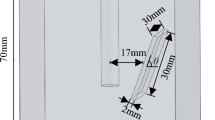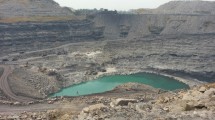Abstract
The mechanical behavior of the brittle-ductile transformation of rock is an important aspect of rock mechanics research. To study the evaluation method of the brittle-ductile transformation of transversely isotropic rock, uniaxial and triaxial compression tests are performed on phyllite samples with different bedding angles to explore the energy evolution process and distribution law of loaded transversely isotropic rock, and an evaluation method of the brittle-ductile transformation of transversely isotropic rock based on energy evolution characteristics is proposed. The results show that the energy density of a rock sample increases with increasing confining pressure, and with the increase in the bedding angle from 0° to 90°, the ability of the rock sample to absorb and store energy before the peak point of the stress–strain curve first decreases and subsequently increases. Based on the energy expansion coefficient K and energy drop coefficient H, it is proposed that the transversely isotropic rock exhibits absolutely brittle, brittle, moderately brittle, ductile, and completely ductile characteristics when 1 < K < 1.5, 1 < K < 1.5, 1.5 ≤ K < 2, K ≥ 2, and K ≥ 3 in the expansion stage before the peak and when H = 0, 0 < H < 1.5, 1.5 ≤ H < 3, H ≥ 3, and H ≥ 5 in the stress drop stage after the peak. By defining the energy-based plastic deformation coefficient S = K + H, when 1 < S < 1.5, 1 < S < 3, 3 ≤ S < 5, S ≥ 5, and S ≥ 8, the transversely isotropic rock exhibits absolutely brittle, brittle, moderately brittle, ductile, and completely ductile characteristics. The experimental results verify the rationality of the proposed index and can improve the evaluation of the brittle-ductile transformation of rock.















Similar content being viewed by others
Data availability
The data used to support the findings of this study are available from the corresponding author upon request.
References
Akdag S, Karakus M, Nguyen GD, Taheri A, Bruning T (2019) Evaluation of the propensity of strain burst in brittle granite based on post-peak energy analysis. Undergr Space 6(1):1–11
Altindag R (2010) Assessment of some brittleness indexes in rock drilling efficiency. Rock Mech Rock Eng 43(3):361–370
Chen GQ, Jiang WZ, Sun X, Zhao C, Qin CA (2019a) Quantitative evaluation of rock brittleness based on crack initiation stress and complete stress–strain curves. Bull Eng Geol Environ 78:5919–5936
Chen W, Konietzky H, Tan X, Fruhwirt T (2016) Pre-failure damage analysis for brittle rocks under triaxial compression. Comput Geotech 74:45–55
Chen ZQ, He C, Ma GY, Xu GW, Ma CC (2019b) Energy damage evolution mechanism of rock and its application to brittleness evaluation. Rock Mech Rock Eng 52(4):1265–1274
Faradonbeh SR, Taheri A, Karakus M (2021) Post-peak behaviour of rocks under cyclic loading using a double-criteria damage-controlled test method. Bull Eng Geol Environ 80:1713–1727
Fu HL, Zhang JB, Huang Z, Shi Y, Chen W (2018) A statistical model for predicting the triaxial compressive strength of transversely isotropic rocks subjected to freeze–thaw cycling. Cold Reg Sci Technol 145:237–248
Gong FQ, Yan JY, Luo S, Li XB (2019a) Investigation on the linear energy storage and dissipation laws of rock materials under uniaxial compression. Rock Mech Rock Eng 52(11):4237–4255
Gong FQ, Yan JY, Li XB, Luo S (2019b) A peak-strength strain energy storage index for rock burst proneness of rock materials. Int J Rock Mech Min 117:76–89
Gong QM, Zhao J (2007) Influence of rock brittleness on TBM penetration rate in Singapore granite. Tunn Undergr Space Technol 22(3):317–324
Hu XC, Su GS, Chen GY, Mei SM, Feng XT, Mei GX, Huang XH (2018) Experiment on rockburst process of borehole and its acoustic emission characteristics. Rock Mech Rock Eng 52(3):783–802
Huang XR, Huang JP, Li ZC, Yang QY, Sun QX, Cui W (2015) Brittleness index and seismic rock physics model for anisotropic tight-oil sandstone reservoirs. Appl Geophys 12(1):11–22
Hucka V, Das B (1974) Brittleness determination of rocks by different methods. Int J Rock Mech Min 11(10):389–392
Jin XC, Shah SN, Roegiers JC, Zhang B (2014) Fracability evaluation in shale reservoirs–an integrated petrophysics and geomechanics approach. Spe J 20(3):518–526
Kim T, Hwang S, Jang S (2017) Petrophysical approach for S-wave velocity prediction based on brittleness index and total organic carbon of shale gas reservoir: a case study from Horn River Basin, Canada. J Appl Geophys 136:513–520
Lawn BR, Marshall DB (1979) Hardness, toughness and brittleness: an indentation analysis. J Am Ceram Soc 62(7/8):347–350
Lee YK, Pietruszczak S (2015) Tensile failure criterion for transversely isotropic rocks. Int J Rock Mech Min 79:205–215
Li DY, Sun Z, Xie T, Li XB, Ranjith PG (2017) Energy evolution characteristics of hard rock during triaxial failure with different loading and unloading paths. Eng Geol 228:270–281
Li N, Zou YS, Zhang SC, Ma XF, Zhu XW, Li SH, Cao T (2019) Rock brittleness evaluation based on energy dissipation under triaxial compression. J Pet Sci Eng 183:106349
Liu XB, Zhang ZY, Ge ZL, Zhong CL, Liu L (2021) Brittleness evaluation of saturated coal based on energy method from stress-strain curves of uniaxial compression. Rock Mech Rock Eng 54(6):3193–3207
Majeed Y, Abu Bakar MZ, Butt IT (2020) Abrasivity evaluation for wear prediction of button drill bits using geotechnical rock properties. Bull Eng Geol Environ 79:767–787
Meng FZ, Zhou H, Zhang CQ, Xu RC, Lu JJ (2015) Evaluation methodology of brittleness of rock based on post-peak stress–strain curves. Rock Mech Rock Eng 48(5):1787–1805
Munoz H, Taheri A, Chanda EK (2016a) Fracture energy-based brittleness index development and brittleness quantification by pre-peak strength parameters in rock uniaxial compression. Rock Mech Rock Eng 49(12):4587–4606
Munoz H, Taheri A, Chanda EK (2016b) Rock drilling performance evaluation by an energy dissipation based rock brittleness index. Rock Mech Rock Eng 49(8):3343–3355
Peng RD, Ju Y, Wang JG, Xie HP, Gao F, Mao LT (2015) Energy dissipation and release during coal failure under conventional triaxial compression. Rock Mech Rock Eng 48(2):509–526
Quinn JB, Quinn GD (1997) Indentation brittleness of ceramics: a fresh approach. J Mater Sci 32(16):4331–4346
Song HQ, Zuo JP, Chen Y, Li LY, Hong ZJ (2019) Revised energy drop coefficient based on energy characteristics in whole process of rock failure. Rock Soil Mech 40(1):91–98 ((in Chinese))
Taheri A and Munoz H (2016) New brittleness indices to describe rock failure under compressive load, rock dynamics: from research to engineering, Proceedings of the 2nd International Conference on Rock Dynamics and Applications, Edited by Jian Zhao, CRC Press, 489–494.
Tarasov BG, Potvin Y (2013) Universal criteria for rock brittleness estimation under triaxial compression. Int J Rock Mech Min 59(4):57–69
Tien YM, Kuo MC, Juang CH (2006) An experimental investigation of the failure mechanism of simulated transversely isotropic rocks. Int J Rock Mech Min 43(8):1163–1181
Wang JA, Park HD (2001) Comprehensive prediction of rockburst based on analysis of strain energy in rocks. Tunn Undergr Space Technol 16(1):49–57
Wang QS, Chen JX, Guo JQ, Luo YB, Wang HY, Liu Q (2019a) Acoustic emission characteristics and energy mechanism in karst limestone failure under uniaxial and triaxial compression. Bull Eng Geol Environ 78:1427–1442
Wang Y, Tan WH, Liu DQ, Hou ZQ, Li CH (2019b) On anisotropic fracture evolution and energy mechanism during marble failure under uniaxial deformation. Rock Mech Rock Eng 52:3567–3583
Xia YJ, Li LC, Tang CA, Ma S, Li M, Bao CY (2016) Rock brittleness evaluation based on stress dropping rate after peak stress and energy ratio. Chin J Rock Mech Eng 35(6):1141–1154
Xia YJ, Li LC, Tang CA, Li XY, Ma S, Li M (2017) A new method to evaluate rock mass brittleness based on stresse-strain curves of class I. Rock Mech Rock Eng 50(5):1123–1139
Xie HP, Li LY, Peng RD, Yang J (2009) Energy analysis and criteria for structural failure of rocks. J Rock Mech Geotech Eng 1(1):11–20
Zhang JB, Fu HL, Huang Z, Wu YM, Chen W, Shi Y (2019a) Experimental study on the tensile strength and failure characteristics of transversely isotropic rocks after freeze–thaw cycles. Cold Reg Sci Technol 163:68–77
Zhang Y, Feng XT, Yang CX, Han Q, Wang ZF, Kong R (2021) Evaluation method of rock brittleness under true triaxial stress states based on pre-peak deformation characteristic and post-peak energy evolution. Rock Mech Rock Eng 54(3):1277–1291
Zhang Y, Zhao T, Taheri A, Tan Y, Fang K (2019b) Damage characteristics of sandstone subjected to pre-peak and post-peak cyclic loading. Acta Geodyn Geomater 156(2):143–150
Zhou H, Chen J, Lu JJ, Jiang Y, Meng FZ (2018) A new rock brittleness evaluation index based on the internal friction angle and class I stress–strain curve. Rock Mech Rock Eng 51(7):2309–2316
Zuo JP, Huang YM, Xiong GJ, Liu J, Li MM (2014) Study of energy-drop coefficient of brittle rock failure. Rock Soil Mech 35(2):321–327 (in Chinese)
Acknowledgements
The authors express special thanks to the editors and anonymous reviewers for their constructive comments.
Funding
This study was financially supported by the National Natural Science Foundation of China (Grant No. 52108367), the Innovation Project of Guangxi Graduate Education (Grant No. YCSW2021021), and the Science and Technology Department of Guangxi Zhuang Autonomous (Grant No. AD21238018).
Author information
Authors and Affiliations
Corresponding author
Rights and permissions
Springer Nature or its licensor (e.g. a society or other partner) holds exclusive rights to this article under a publishing agreement with the author(s) or other rightsholder(s); author self-archiving of the accepted manuscript version of this article is solely governed by the terms of such publishing agreement and applicable law.
About this article
Cite this article
Zhang, J., Zhang, X., Huang, Z. et al. A brittle-ductile index for transversely isotropic rock based on energy evolution of the characteristic stress and its application. Bull Eng Geol Environ 82, 35 (2023). https://doi.org/10.1007/s10064-022-03060-9
Received:
Accepted:
Published:
DOI: https://doi.org/10.1007/s10064-022-03060-9




